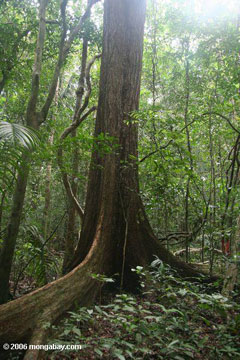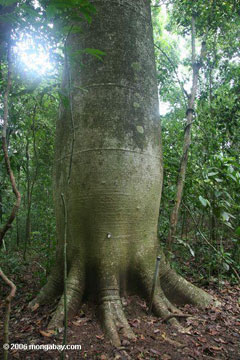  Photos taken in Panama by Rhett A. Butler. |
Drought could cause dramatic shifts in rainforest plant communities in Central America, reports a new study published in the May 3 issue of Nature. The research shows that many rainforest plants are ill-equipped to deal with extended dry periods, putting them at elevated risk from changes in climate projected for the region.
Measuring the drought tolerance of 48 plant species across 122 tropical forest plots in Panama, a team of researchers led by Dr. Bettina Engelbrecht of the University of Kaiserslautern in Germany and the Smithsonian Tropical Research Institute (STRI) found that drought tolerance was key factor in the distribution of rainforest plant species.
“Drought tolerance was a stronger predictor of species distributions for saplings and adult trees than for seedlings, implying that plant community composition adjusts in accordance to environmental constraints,” explained a release from STRI.
“With future global change, the main changes projected for the tropics are not increases in temperature, but substantial shifts in rainfall patterns. This is due to large-scale meteorological processes associated with global climate change, but also at a more regional or local scale it is due to changes in land use, mostly forest destruction and fragmentation,” Engelbrecht old mongabay.com via email. “If we want to understand the consequences of such shifts, we have to understand the direct role of rainfall and drought periods for tropical forests. Our results show that – while humid tropical forests are commonly considered water saturated – drought really plays a large role in structuring these plant communities.”
The findings may have implications for other tropical forests projected to face worsening drought in the future, notably Indonesia and the Amazon.
The results not only help forecast the impact of climate change in the tropics, but provide insight on what drives plant diversity in the rainforest, says Engelbrecht.
“Our data show, that dramatic shifts in species distributions, community composition, forest diversity and ecosystem functioning have to be expected, even with relatively small changes in dry season lengths’ (of about one month). Such an understanding provides the basis for modeling the consequences of future climate change, and also is important for making informed decisions about forest conservation and management,” Engelbrecht concluded.
CITATION: Bettina M. J. Engelbrecht, Liza S. Comita, Richard Condit, Thomas A. Kursar, Melvin T. Tyree, Benjamin L. Turner, Stephen P. Hubbell. Drought sensitivity shapes species distribution patterns in tropical forests. Nature. May 3, 2007